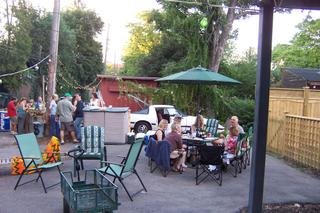From time to time we all need to do some repair work to the brick surfaces of these century homes. Whether it be to replace the odd brick here and there or the much more laborious and mind deadening job of pointing. It seems and looks easy enough but there is some science and skill required. A history lesson too. Don't take exterior walls, foundations and chimneys for granted - they won't last forever if not maintained properly. Examine them closely for signs of decay, and look especially at the mortar joints. If you see signs of cracked, crumbly or missing mortar be prepared to fix them immediately. If left unattended moisture and creatures will further undermine the integrity of the structure.
Repointing, which is the practice of repairing mortar joints, is the most common activity related to maintaining these Monmouth Road structures. It is also the most misunderstood. Evidence of yesteryear's mistakes is abundant. The number one thing to remember is that today's mortar materials are not compatible with the older style bricks used to build these homes. Whether you decide to tackle it yourself or if you hire the job out you should be well enough acquainted with the art of repointing to ensure that the job is done right.
A fundamental rule is that any new mortar joint should match the original in colour, shape, size, material and texture. Above all, the Mortar itself should be slightly softer and more porous than the soft, hand made, dome fired bricks used to build these Monmouth homes. Where harder, modern mortar has been used for repairs in the past we see the problems it has caused. Cracked and spawled bricks top the list. Masonry walls built in Canada before the First World War were constructed using
lime-based mortar. (The key binder being "slaked lime"). This material offers important advantages; it is flexible, weaker and more porous than today's "cement" based mixture. This allows the walls of a building a little freedom to sag or bulge slightly before any serious cracking occurs. If movement tends to be too great the mortar will fail first, leaving the brick in tact and the joints easy to repair. The greater porosity of the lime mortar encourages the evaporation of moisture through the joints rather than the bricks, minimizing the damage that results from freeze-thaw or wet-dry cycles. This damage usually occurs in the form of "spawling" where the surface of the brick cracks and falls away. The beauty in lime based mortar is that it is self healing. That is; every time it gets wet it re-sets itself. This is why it has held up so well for well over a century. In contrast, today's
cement-based mortar is much less tolerant of movement and far harder and stronger than our bricks. It is only intended for and should only be used with more modern and much harder bricks. Take a closer, more intimate look at your bricks. Touch em, feel em and run your fingers through the mortar joints. This foreplay is vital to a successful end.
Tools of the Trade
Here's everything you will need to lick your bricks:
- A new plastic garbage pail with lid (for making and storing slaked lime)
- A one quarter inch brick lick.
- A brick skate. (buy one for $20.00 or make one from a piece of two by two with a cement nail tip protruding through)
- A small pail or clean container to mix the mortar.
- A diamond shaped or rectangular trowel.
- One spritzer bottle full of clean water.
That's all there is.
Slake it Baby.
Before you can prepare the original recipe you have to make some slaked lime. This takes a little time but not the 3 to 4 months it used to take in the old days. Slaked lime is the binder for our mortar mix. Here's the recipe:
- 2 bags of pre-hydrated lime
- clean water
- Put some clean water in the bottom of a garbage pail. (4 to 5 inches)
- Pour one bag of lime into the pail .
- Cover it with another 4 to 5 inches of water.
- Stir with a spade and add a little more water until there is enough to saturate the mass. Any excess water will rise to the top by the next morning. The mixture should have the appearance of a thick white paste.
- Cover the garbage can with a lid to keep the rain and leaves out. Try to store indoors. Check occasionally to make sure that there is always some water on top.
The Original Recipe
- One part white Portland cement
- Two parts slaked lime
- Nine parts sand (the original used coarse river sand)
- Measure the ingredients as per the recipe with mixing boxes ( a box full is more accurate than a shovel full).
- Blend in a wheelbarrow, starting with the sand and then with the slaked lime. Using a spade or hoe, mix with a chopping or folding action. The material will seem stiff and dry at first but as the lime mixes in it will get easier.
- When it has a consistent appearance the cement can be added. This will appear to dry the mixture out a little. Now is the time to add water. Add about half of the water you think is necessary; you can always add more later if needed. To avoid shrinkage and to achieve maximum strength the mortar should be kept just wet enough to cling upside down on a trowel. Mix only what can be used in less than two hours.
It's OK to be Unfaithful.
Most of us do not have to get so involved because there's a quickie alternative. Because most of us will be doing superficial spot tucking we can use a product called "Restomix" which is available at Patene Bros. on Walker Road. Mix it with clean water to the desired consistency and presto...You're ready to point. Two things to remember about this product:
- It comes in two colours; white and grey. You want white.
- It is only intended for standard pointing as it is not structural enough for larger repairs. For those you will also need "N-Type" mortar).
Licking it and Liking it.
This is the most boring and mind deadening job on the planet. It's slow and tedious. Because of this, only commit to doing the needed repairs at any given session. Don't fix what ain't broke. Take your spritzer and soak the brick surfaces which you are going to work on. Hold your trowel upside down (handle down). Place some mortar mix on the flat of the trowel and hold the edge of the trowel to the bottom edge of the brick coarse. Using your lick, carefully press the mortar into the mortar coarse and smooth (tool) it out to match the existing mortar profile. Do all horizontal coarses first and then do the verticals. If you get any mortar on the surface of the brick wipe it off immediately with a wet rag. **Some of the terraces on Monmouth Road have a red mortar. Be sure to add the proper pigment (available at your favourite building center). Only do as much as you can stand in a given session (mind deadening, tedious work). Pick up the job again whenever you're in the mood. Before long you will have everything repaired and looking great. Another job well done! Those are the basics. If you have any specific questions please use the comments section of this blog. Please print this recipe stuff out and keep it in a safe place. The more of us who have it, the less likely it will get lost. Please share it with your neighbours. Pointing is bliss.
The Tools are all Available at Home Depot or Lowes:
 |
| Spray Bottle |
 |
| Brick lick |
 |
Trowel
|
The Stuff is Called Restomix availble at Patene Bros.:
http://www.patene.com/
 |
| Restomix |

![]()









 We'll be posting reminders until the final event. Stay tuned.
We'll be posting reminders until the final event. Stay tuned.![]()




![]()